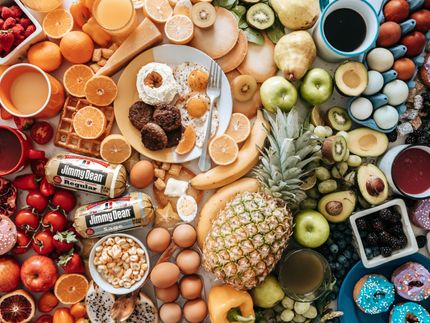4500 finished products examined - product monitoring 2021
Sugar, salt, fat and energy at a glance
With the report "Product Monitoring 2021", the Max Rubner Institute once again publishes up-to-date results on energy and nutrient content in ready-to-eat foods. Since 2016, a baseline survey has been conducted for 22 product groups and follow-up surveys for 14 product groups on behalf of the German Federal Ministry of Food and Agriculture as part of the National Reduction and Innovation Strategy. Results are now available for the contents of energy, sugar, fat, saturated fatty acids and salt for pasta sauces, cold sauces, frozen complete ready meals, meat substitutes and sausage substitutes, and pastries. A total of almost 4500 products were examined.

Bild von Gundula Vogel auf Pixabay
The results of the product monitoring are presented in each case for the breadth of the product spectrum as well as for the market-relevant products. The breadth of the spectrum aims to include as many of the products available on the German market as possible and also includes products with a small market share or those that are new to the market. The evaluations of market relevance, on the other hand, include particularly strong-selling products. The basis for the assessment of market relevance is the representative household panel of the market research company GfK.
The report presents the average contents of energy, sugar, fat, saturated fatty acids and salt, the minimum and maximum values and other statistical parameters in tabular form. In addition to the current energy and nutrient contents, changes from the baseline to the follow-up survey are also presented for the product subgroups. In addition to significant decreases, significant increases are also examined for the first time in this report.
Results
One focus of the product monitoring is again on the particularly sensitive group of children. In the case of products with a children's look, it can be seen that these predominantly have lower energy, fat, sugar and salt contents than comparable products without a children's look, or at least are in the same range. For example, ketchups with a children's look contain less energy and sugar than tomato ketchups without a children's look and have the lowest salt content within the cold sauces. For the total of pastries with child optics, the levels of saturated fat and sugar are lower compared to the baseline survey. However, wafer pastries with child optics stand out due to comparatively high fat contents.
Pasta sauces contain less salt on average than in the 2016 baseline survey. This is true for the overall sample, but also for the subgroups bologna sauces with meat and tomato sauces with vegetables/mushrooms. Containing less energy and fat compared to the 2016 survey are the light pasta sauces, for example carbonara. The group of cold sauces includes, for example, ketchup or barbecue sauces. Here, compared to the 2016 baseline survey, the sweet and sour/sweet and spicy sauces in particular stand out due to higher contents of energy, sugar and salt. Tomato ketchup and spicy ketchup, on the other hand, contain less salt than in 2016. The majority of the surveyed product subgroups of frozen complete ready meals contain a median of less than one gram of salt per 100 g of product. Overall, products with very high salt content have low market relevance. The range of meat substitutes and sausage substitutes on the market is steadily increasing. Compared to the 2016 baseline survey, the energy and saturated fat contents of meat substitutes and sausage substitutes were significantly higher in the overall 2021 sample.
Pastries such as cookies and wafers are purchased by almost all households. Compared to the 2016 baseline survey, the products in the 2021 sample were found to contain less sugar, but also more fat or saturated fatty acids, for the overall sample and for several product subgroups.
A comparison of the energy and nutrient contents of the finished products studied in the baseline survey with the current 2021 survey reveals a continuous trend: The market supply is partially expanding toward products with lower contents, and in some cases significant reductions could be observed compared to the baseline survey. Nevertheless, products in the upper ranges of energy and nutrient content continue to be on the market. The fact that in some product groups the energy and nutrient contents are increased compared to the baseline survey indicates that there is further reduction potential.
Note: This article has been translated using a computer system without human intervention. LUMITOS offers these automatic translations to present a wider range of current news. Since this article has been translated with automatic translation, it is possible that it contains errors in vocabulary, syntax or grammar. The original article in German can be found here.





























































